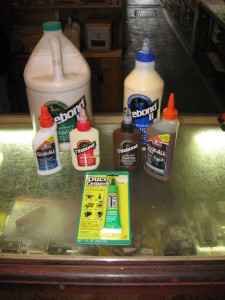One group of items in the fastening category that is not usually thought of as a fastener is glue. Glue can be very handy to fasten things together when something has broken and fixing it with nails or screws is either not possible or too unsightly. It can also be used to construct things from scratch when used correctly within its limitations.
One type of glue that everyone is familiar with is “Elmer’s” or plain white glue. While most of us used it in grade school for gluing paper “cut and pastes”, it is also handy for gluing wood and most other porous materials. Stronger wood-specific glue is also available in good, better, best varieties that can be used for furniture repair and construction. The basic type is similar to white glue in that it is not water resistant and if your project will be exposed to moisture you should use one of the better glues rated for water contact. These glues are similar to the old organic glues of the past, although those desiring absolute authenticity can still buy the original hide glue.
The key to successful usage of these glues is to apply them to a clean close fitting joint and then clamp them until they are dry. Now don’t pretend that you didn’t read that last sentence. These glues will simply not hold well unless they are clamped at least overnight. A variety of spring, screw, bar and band clamps are made that will fit almost any project.
Fairly new on the scene are polyester glues of the “gorilla type”. Also made by other manufacturers, these glues are actually activated by water and the surfaces must be dampened for the glue to set. It will then harden into a very strong joint. Other than that the other wood glue rules still apply and the joint must be clamped and must set overnight.
If you can’t wait for regular glue to dry, solvent based household glues are available that dry quicker. Speaking of quick, instant or “super” glues are the fastest of them all. Generically known as aerobic adhesives these miracle glues only set in the absence of air. They will remain liquid on the surface until you bring them together and then – look out! These adhesives set up in a few seconds and are famous for sticking fingers and other body parts together so be careful. These adhesives provide a very strong bond, but will not fill gaps, so only use them where the fit up between the mating parts is good.
If your repair or construction job requires filling a good sized gap there is a product specially made for that job, but you’ll have to wait until next time, Epoxy!

